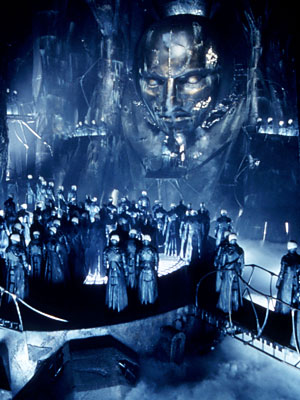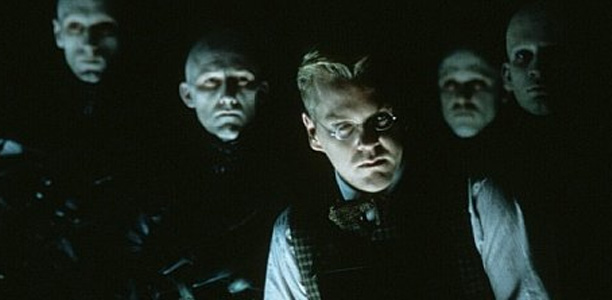Alex Proyas can not be described as a lucky director. During the shooting of his critically acclaimed gothic comic book tale The Crow star Brandon Lee succumbed to the Lee family ‘curse’. He died after the powder cap of a blank cartridge bizarrely exited a prop firearm and penetrated his spinal cord. The film was completed with the help of some then cutting edge CGI work and did brisk business but was a broken facsimile of Proyas’s original vision.
It was unfortunate that ten years later in I, Robot, Will Smith’s ludicrous future-fashion sense did not similarly result in a stunt player popping a cap in the Fresh Prince’s lop-sided beeny hat clad dome, saving us the indignity of further white sugar-shit versions of beloved sci-fi classics. Smith’s presence condemned a long anticipated Asimov adaptation to facile blockbuster status and critical ignominy.
In between these two casualties of adversity fell Proyas’s most sophisticated and least tainted major studio film to date.
Dark City was released in 1998 to no fanfare by New Line Cinema but has since developed a huge fan base thanks to the slow burn DVD phenomenon. Ten years on Proyas has unleashed a newly polished and tightened director’s cut. This new cut dispenses immediately with the idiot’s guide narration, which introduced the theatrical cut and gave away a large part of the game. Instead it begins with the simple downward sweep from the starlit night sky to the figure of Keifer Sutherland as Doctor Schreber and the exaggerated and architectonic lines of perhaps the most important character in the film, the City itself.
Like the previous year’s The City of Lost Children the environment through which Dark City‘s characters pass is unashamedly expressionistic and reminiscent of the environments and sets in Fritz Lang’s Metropolis and M. But unlike Jeunet and Caro’s fantastical masterpiece, the City here is explicitly modeled upon the American megalopolises of the 1940s and at street level evokes the juxtaposition of dark foreboding streets and brightly lit sanctuaries found in the paintings of Edward Hopper. This simple but effective device lends considerable weight to the feeling of isolation and confinement that the City’s occupants feel from the very outset.
Protagonist (Rufus Sewell) is introduced as a naked amnesiac in a cold, murky bathroom. He quickly finds that although he has no memory of himself, his past or his situation he is apparently called John Murdoch and appears to have brutally and ritualistically killed a young woman. Murdoch soon discovers that the City is not as it seems. Every night at midnight enigmatic black leather and fedora clad ‘Strangers’ send the population to sleep and reorder their lives and memories whilst the City itself warps and shifts into new configurations.
The ‘dislocated man’ is a common conceit in fiction. It invites the audience to shadow the protagonist and vicariously experience the unravelling of plot and intrigue. This most Jungian of plot devices has littered film noir, horror, crime thrillers and science fiction since these genres began. Widely read and adapted genre authors like Philip K Dick, and H.P. Lovecraft have been writing such stories of alienation, loss of identity and the isolation of a transient human existence shaped by forces beyond individual control or comprehension.

In Dark City, Murdoch is not alone in his isolation, every occupant of the City obliviously wakes to a new set of memories, doomed to continue their S.A.D. plagued existence in a perpetual night-time world devoid of natural light. Thanks to his amnesia, Murdoch questions whether he is capable of the brutal murder of a woman and his ensuing quest brings him into contact with his wife Emma (Jennifer Connelly) and police detective Inspector Bumstead (William Hurt). In the director’s cut these two characters are afforded a more subtle progression beyond their existence as repressed, emotionally blunted sleepwalkers suffering an imposed psychosis. Scenes that felt disingenuous in the theatrical cut now resonate deeply. Inspector Bumstead in particular describes a more considered arc as he witnesses the mental deterioration of his more self-aware partner and begins to question the vagaries of his own memory.
It is no accident that the human doctor used by the Strangers to formulate and administer the false memories is called Daniel Paul Schreber. Proyas named him after the German judge who chronicled his own descent into schizophrenia in Memoirs of my Nervous Illness, on which the predicament of Murdoch and co. is loosely based. The Strangers are agents of an imposed collective reality which enforces a constructiveness which is contraindicative to the very subjective and personal existence which people need in order to function effectively and maintain their sanity. It is this innate need that propels Murdoch, Emma and Bumstead to discover the truth about the City, Schreber and the Strangers. Their journey of discovery leads to a truly breathtaking reveal of the City’s true nature and, despite a somewhat formulaic Prometheus Unbound climax, the whole shebang makes for one of the most unique and satisfying film experiences since Blade Runner.

On its release America’s most respected film critic Roger Ebert described Dark City as "intelligent, intriguing, darkly atmospheric and most of all visually breathtaking" and later proclaimed it the best film of 1998. Sadly this glowing endorsement did little to assure a healthy return on New Line’s investment. Their own executives didn’t understand the film and failed to argue its case with the MPAA or even promote it effectively. As a result it was saddled with an R-Rating and sank without trace. The Matrix told roughly the same story a year later, replacing finesse and subtlety with Kung Fu and MTV soundtrack and it took the world by storm. Inevitably The Matrix‘s bleak sago pudding fuelled future gave way to all night raves, onion bhajis and cod spiritualism in two risible sequels.
In an ideal world an intelligent and demanding film such as Dark City would get the recognition and wider release that it deserves. Unfortunately it exists in a world where children can take calculators into maths exams and random teenagers at preview screenings dictate what’s hot and what’s not in the state of an artistic medium.

Fortunately we have DVDs and in a documentary on the new release Rufus Sewell succinctly addresses the thorny issue of alienating less cranial audiences and studio executives when he says, "…fuck ’em!"



